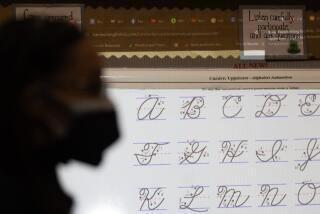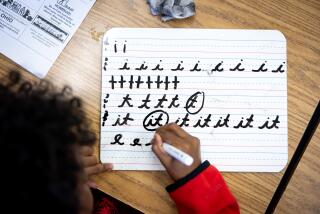Centuries Can’t Erase Chalkboard’s Role in Teaching Students
- Share via
Nearly every California classroom has one, or something similar to it.
The ultimate in low-tech, it has changed little in nearly seven centuries. Schools in ancient Rome used it as far back as the early 3rd Century, when it was called a titulus in Latin.
It makes students use both the left (analytical) and right (visual) halves of their brains, which produces better understanding and memorization.
Simple, inexpensive and maintenance-free, the chalkboard has endured because it works.
Writing or drawing on a board seems easy enough, but there’s a technique to using one effectively. Education guru Madeline Hunter devotes a chapter to it in her popular teacher training textbook, and many recently trained teachers (including me) have been lectured and tested on the right way to use a chalkboard.
The first consideration is brevity. While lecturing or leading a class discussion, it’s tempting to try to write on the board everything that is said.
That’s a problem for a couple reasons: Teachers can’t write as fast as they talk, and it’s difficult for the students to separate the important from the trivial.
Also, students miss a lot of what the teacher says because they’re too busy reading the board.
It’s better to write down only key words or short phrases, not whole sentences. For example, I look over my lesson plan beforehand and underline only the most necessary words.
I also look for concepts that can be conveyed in a nice low number that helps memorization, such as “five parts of a literary plot,” or “two kinds of literary characters.”
The chalkboard is less useful for complex concepts and diagrams. These are best presented through printed handouts that students can examine at their leisure and refer to repeatedly.
Saying a word or phrase a couple times before writing it on the board is crucial too. That way, the student can start wondering about it immediately.
And, by hearing the word, seeing it, then writing it, the student gets three good shots at remembering it.
It’s also important to show the correct relationships between items written on the board. Making an outline beforehand helps a teacher to neatly show chronological order, relative importance, cause-and-effect and other relationships.
This is done with timelines, arrows, asterisks, variation of print size and spatial positioning.
Colored chalk can help in categorizing or emphasizing.
This way, while the right brain sees the ideas written on the board, the left brain interprets the relationships between them.
It’s easy to go overboard with visual gimmicks though, and a chalkboard crammed full can defeat its own purpose by confusing the students.
So tidiness is another consideration. In the throes of a smooth lecture or heated class discussion, it’s easy to load the board with too many words, sketches and symbols.
Taking a minute to erase the whole board is much better than confusing the students by erasing a piece at a time and having unrelated ideas adjoined or overlapping. Besides, the pause also gives the students a chance to absorb, formulate questions and prepare for the next round.
Finally, I make clear to my students that the reason I’m writing material on the board is that it’s important. “What goes on the board, goes in your notes,” I tell them. Otherwise, no matter how much colored chalk I use, half the lesson will be forgotten by lunchtime.
This point helps students sharpen their note-taking skills. They develop a better sense of what’s important in a lecture or discussion, which will help them in college courses that are generally lecture-based.
And, at the end of the lesson, their chalkboard notes provide a neat, complete and accurate outline for study.










